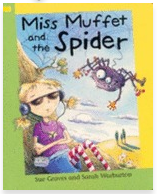Fictional Narrative
Little Miss Muffet sat on her tuffet, but that's not how this story goes. Instead, this is a tale of discovery and adventure. Miss Muffet had plenty of time to contemplate what she wanted to do as she sat eating her curds and whey. She was off to see the world, she decided, and so she packed her bags, picked up her handy geological guide, and she and her trusty friend spider set off.
First, they went to explore some caves. Their handy book was able to teach them all kinds of interesting facts about how caves are made, like the fact that they are commonly formed from limestone. The caves were beautiful with formations called stalagmites, they grew from the floor, and stalactites grew like icicles from the roof. "The formations come from the calcium that builds up from the dripping water.", said Miss Muffet. "Yes!", exclaimed spider, "They are called speleothems." "Kind of sounds like something someone at Hogwarts would say.", replied Miss Muffet. Spider silently agreed as they continued their spelunking.
Next in their travels they came to China's Li River Valley. "Did you know", said Miss Muffet to Spider, "This valley was once a series of caverns? Now all that remains are pillars of limestone. The rest was washed away years ago. According to the geological guide this is a type of karst topography." Fascinated and eager to learn more, they moved on. The guide book recommended Timaru, New Zealand as a great place to see other karst topography called sinkholes. These fascinating land forms could swallow huge trees, whole buildings, and even streams disappear down them to become underground streams."Who knew so many interesting things came from limestone?", said spider. "So true!" Agreed Miss Muffet.
The next place of interest was Greenland and the ice cap. This was described as an ice sheet but smaller. An ice sheet is a continental glacier that can cover up to 50,000 square kilometres. the cap was smaller, but similar. "Fun fact", stated Spider, "Ice sheets have covered part of Greenland for the last 18 million years." "Wow!", exclaimed Miss Muffet. "I read that in Wikipedia.", said Spider proudly.
The trip continued as they explored lakes from kettles, created when blocks of ice from glaciers became surrounded and buried by sediment. "When the ice melted", read Miss Muffet, "Depressions would form and later fill with water to become a lake." Taking the book from Miss Muffet, Spider continued to read, "Kame are similarly made. They are low mounds formed from outwash deposited on a stagnant glacier." he continued, "Outwash is the debris from a glacier's meltwater. Unlike other glacial till, the debris is well sorted and layered like one would find in a stream." "That must be because of the flowing water." observed Miss Muffet. As they continued exploring they discovered more of kame and kettle topography. They saw drumlins, bodies of till shaped into streamline hills parallel to the flow of the glacier, they also saw esker, which are fascinating sinuous ridges of well sorted, cross bedded till formed under the ice sheet in tunnels of outflow from beneath or within the glacier.
Before they knew it, it was time for Miss Muffet and Spider to go home. The trip was amazing and they learned a lot. "Next time", said Miss Muffet, "We will explore the United States and Canada. I want to see alpine glaciers. The book tells us there are different kinds of formations there than in continental glaciers." "Very exciting!", agreed Spider. "By the way", he asked, "What is the name of the book we've been reading?" "Oh! Well, it's Physical Geology, by McGraw-Hill Connect." she replied. "We'll bring it along again next time."



Comments
Post a Comment